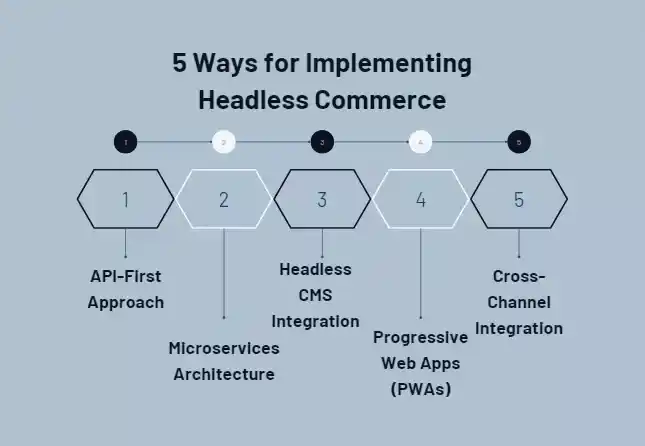Table of Contents
Entering the realm of implementing headless commerce signifies a voyage into the boundless horizons of innovation and adaptability within the digital marketplace. Businesses, driven by a strategic vision of growth, find in this approach a means to redefine their online presence. By dissociating the front-end presentation layer from the back-end commerce functionalities, organizations secure the nimbleness required to swiftly respond to evolving consumer preferences.
In today’s ever-changing landscape, harnessing the prowess of implementing headless commerce becomes indispensable for maintaining competitiveness. This transformative journey unfolds not merely through one, but through myriad potent avenues, each capable of propelling growth and enriching customer interactions.
Through meticulous planning and execution, enterprises unveil five distinct pathways, each brimming with newfound opportunities for expansion and triumph. From seamless integrations to personalized experiences, the journey of headless commerce unveils a world of possibilities awaiting those ready to embark on this transformative expedition.
Here are five different ways to implement headless commerce:

1. API-First Approach
Implementing headless commerce through an APi-first approach entails leveraging a commerce platform that offers a comprehensive set of APIs, granting access to essential functionalities like product catalog management, inventory control, cart management, and checkout processes. With this foundation, developers gain the freedom to craft tailored front-end experiences across various platforms such as web, mobile, and IoT devices.
By consuming these APIs, developers can design interfaces that perfectly align with their brand’s vision and user experience goals. This methodology introduces a level of flexibility unparalleled in traditional commerce architectures. Businesses can swiftly adapt to changing market demands and consumer preferences, thanks to the agility provided by headless commerce. Moreover, the API-First Approach facilitates rapid development cycles, allowing teams to iterate quickly and efficiently.
This agility proves invaluable in today’s fast-paced digital landscape, where staying ahead of the competition requires responsiveness and innovation. Ultimately, by embracing an API-First approach to headless commerce, businesses empower themselves to deliver seamless, engaging experiences to their customers across a multitude of touchpoints, driving growth and success in the digital realm.
2. Microservices Architecture
Implementing headless commerce through a microservices architecture revolutionizes the traditional approach. Unlike monolithic platforms, this strategy disassembles commerce functionalities into discrete, self-contained services. Each service, dedicated to tasks like product management, order processing, or payment handling, operates autonomously and communicates through APIs. This segmentation fosters scalability, enabling businesses to scale individual components independently to meet evolving demands.
Moreover, fault isolation ensures that issues within one service don’t cascade throughout the system, maintaining overall system integrity. Additionally, microservices empower agile development by facilitating updates to individual services without disrupting the entire ecosystem. This flexibility allows for rapid iteration and deployment of new features or enhancements, ensuring businesses stay ahead in dynamic market environments. By embracing a microservices architecture, companies embarking on headless commerce journeys unlock unparalleled agility, scalability, and resilience, paving the way for sustainable growth and competitive advantage.
3. Headless CMS Integration
Implementing headless commerce involves leveraging innovative strategies to enhance business growth. One powerful method is Headless CMS Integration. Traditional CMS platforms manage website content and presentation together. However, with a headless CMS, content management is separated from presentation, offering greater flexibility. By integrating a headless CMS with a commerce platform, businesses can efficiently manage product information, marketing content, and related data independently of the front-end presentation layer.

This decoupling empowers marketers and content creators to maintain control over content while developers concentrate on crafting dynamic user experiences. For instance, product descriptions, pricing, and promotions can be updated swiftly without impacting the website’s design or functionality. Moreover, content can be optimized for different channels seamlessly, ensuring consistent branding across all touchpoints. With Headless CMS Integration, businesses can streamline content management processes, enhance agility, and deliver personalized experiences to customers, ultimately driving growth and success in the competitive digital landscape.
4. Progressive Web Apps (PWAs)
Implementing headless commerce involves leveraging modern strategies like Progressive Web Apps (PWAs) to enhance the online shopping experience. PWAs utilize contemporary web technologies to offer app-like functionalities on web browsers. By implementing headless commerce principles with PWAs, businesses can develop fast, engaging, and reliable web experiences.
These experiences are designed to seamlessly operate across various devices and platforms, ensuring consistent accessibility for customers. PWAs, when combined for implementing headless commerce, can consume commerce APIs to retrieve product information, handle transactions, and manage user sessions. This integration enables a unified shopping journey regardless of the device or browser used by the customer.
With PWAs, businesses can deliver enhanced user experiences, including offline capabilities and push notifications, further enhancing customer engagement and retention. This approach not only improves the user experience but also streamlines development and maintenance efforts, making it an attractive option for businesses aiming to stay competitive in the digital landscape.
5. Cross-Channel Integration
Implementing headless commerce revolutionizes the way businesses engage with customers through Cross-Channel Integration. With headless architecture, companies can seamlessly deliver consistent commerce experiences across diverse channels, such as web, mobile, social media, voice assistants, and IoT devices. Leveraging APIs and microservices, they integrate commerce functionalities into each channel, enabling customers to browse, purchase, and interact with products seamlessly.
For instance, a customer might discover a product on social media, add it to their cart via a mobile app, and complete the purchase through a voice assistant—all without disruption. However, executing this strategy requires meticulous orchestration and integration to ensure a unified brand experience across all touchpoints.
By adopting headless commerce, businesses can effectively capitalize on the omnichannel landscape, reaching customers wherever they are and delivering personalized experiences that drive engagement and loyalty. This cohesive approach not only enhances customer satisfaction but also boosts brand visibility and revenue potential in an increasingly competitive market.

Implementing Headless Commerce: A Forward-Thinking
Implementing headless commerce opens a realm of possibilities for businesses seeking innovation and scalability. Each approach offers distinct advantages, tailored to diverse business needs and objectives. Whether prioritizing scalability, flexibility, or customization, evaluating factors like development resources is crucial. A microservices architecture allows for modular scalability and fault isolation. Meanwhile, an API-first approach prioritizes flexibility and rapid development.
Headless CMS integration empowers marketers with content control while developers focus on dynamic experiences. Progressive web apps offer seamless, app-like experiences across devices. Cross-channel integration ensures a unified brand experience. By carefully considering these options, businesses can unlock the full potential of headless commerce and drive exponential growth.